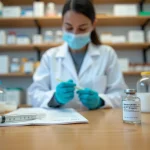You may be thinking, “Lab-grown proteins? That sounds unnatural and unappetizing.”
But let’s take a moment to reconsider. In a world where the demand for food is constantly increasing, and our planet’s resources are being stretched to their limits, we need to explore new and sustainable solutions for food production.
This is where lab-grown proteins come in. Imagine a future where we can enjoy a delicious meal without the guilt of contributing to deforestation, greenhouse gas emissions, or animal cruelty.
Lab-grown proteins offer a promising solution to these pressing issues. By growing proteins in a controlled environment, we can reduce the need for traditional livestock farming, which is a major contributor to environmental degradation.
Additionally, lab-grown proteins have the potential to provide more nutritional benefits and eliminate the risk of foodborne illnesses associated with traditional meat production.
Key Takeaways
- Lab-grown proteins offer a sustainable and ethical alternative to traditional meat production.
- Lab-grown proteins reduce environmental impact of livestock farming (deforestation, greenhouse gas emissions).
- Lab-grown proteins provide more nutritional benefits and eliminate risk of foodborne illnesses.
- Lab-grown proteins contribute to a more sustainable and efficient food system, addressing global food crisis.
The Rise of Lab-grown Proteins
You won’t believe how lab-grown proteins are taking the culinary world by storm, completely revolutionizing the way we think about food!
Imagine a world where you can enjoy the most succulent, mouth-watering dishes without any harm to animals or the environment. Lab-grown proteins are making this a reality, offering a sustainable and ethical alternative to traditional meat.
These proteins are created by culturing animal cells in a laboratory, bypassing the need for animal slaughter. The result is a product that is virtually indistinguishable from traditional meat in taste, texture, and nutritional value. It’s like a miracle of science that allows you to indulge in your favorite dishes guilt-free!
Not only are lab-grown proteins changing the way we eat, but they are also contributing to a more sustainable future. Traditional meat production is a major contributor to greenhouse gas emissions and deforestation. By shifting towards lab-grown proteins, we can reduce our environmental footprint and help combat climate change.
Sustainable Solutions for Food Production
Sustainable solutions are transforming the way food is produced, creating a more environmentally friendly and efficient system. You may not realize it, but by embracing these solutions, you’re not only helping the planet but also profoundly serving others.
One of these solutions is the production of lab-grown proteins, which have the potential to revolutionize the way we eat. Lab-grown proteins are created through cellular agriculture, where cells are grown in a laboratory setting, eliminating the need for traditional animal farming. This means fewer greenhouse gas emissions, less land and water usage, and reduced reliance on harmful pesticides and fertilizers. By choosing to incorporate lab-grown proteins into your diet, you’re contributing to a more sustainable and ethical food system.
Lab-grown proteins also offer a way to address the growing global food crisis. As the world population continues to increase, traditional methods of food production are becoming increasingly unsustainable. Lab-grown proteins provide a solution by being highly efficient in terms of resource usage. They require significantly less land, water, and feed compared to traditional livestock farming. This means that more food can be produced using fewer resources, ultimately helping to alleviate hunger and food insecurity.
Nutritional Benefits and Safety Considerations
When it comes to incorporating lab-grown proteins into your diet, it’s essential to consider the nutritional benefits and safety considerations. Did you know that lab-grown proteins have been found to contain higher levels of essential amino acids compared to traditional meat sources? This means that by adding lab-grown proteins to your meals, you can ensure that you’re getting all the necessary nutrients for your body to function at its best.
To give you a clear picture of the nutritional benefits, let’s take a look at this table:
| Nutrient | Lab-Grown Proteins | Traditional Meat |
|---|---|---|
| Protein | High | High |
| Essential Amino Acids | Higher levels | Lower levels |
| Fat | Low | Varies |
| Cholesterol | Zero | Varies |
As you can see, lab-grown proteins are high in protein content and contain higher levels of essential amino acids. Additionally, they are low in fat and cholesterol, making them a healthier alternative to traditional meat. This is great news for those who are conscious about their health and want to make sustainable choices for themselves and the environment.
Regarding safety considerations, you can be assured that lab-grown proteins undergo rigorous testing to ensure their safety for consumption. They are produced in controlled environments, free from harmful bacteria and potential contaminants. This means you can enjoy lab-grown proteins’ nutritional benefits without worrying about foodborne illnesses or other safety concerns.
Transforming the Food Industry
Get ready to witness a complete transformation of the food industry with the introduction of lab-grown proteins. This groundbreaking technology is set to revolutionize the way we produce and consume food, offering a sustainable and ethical alternative to traditional livestock farming.
Here’s what you can expect from this exciting development:
- Increased sustainability: Lab-grown proteins have the potential to reduce the environmental impact of the food industry significantly. By eliminating the need for large-scale animal farming, we can conserve precious resources like land, water, and energy. This means a smaller carbon footprint and a healthier planet for future generations.
- Enhanced food safety: With lab-grown proteins, you can rest assured that your food is free from harmful contaminants. By controlling the entire production process in a controlled environment, the risk of foodborne illnesses and the use of antibiotics can be minimized. This ensures that you and your loved ones can enjoy daily safe and healthy meals.
- Expanded culinary possibilities: Lab-grown proteins open up a whole new world of culinary creativity. From perfectly marbled lab-grown steaks to sustainable seafood alternatives, the possibilities are endless. Imagine indulging in your favorite dishes without any guilt, knowing that they’re not only delicious but also good for the planet.
- Improved accessibility: Lab-grown proteins have the potential to address issues of food scarcity and malnutrition around the world. With a more efficient production process, these proteins can be made available to a larger population, ensuring that everyone has access to nutritious and affordable food.
How Can Lab-grown Proteins Contribute to Bone Health in Future Diets?
Lab-grown proteins have the potential to provide diverse bone-boosting nutrients that can contribute to bone health in future diets. With the ability to be fortified with essential minerals like calcium and phosphorus, these lab-grown proteins offer a promising source of nutrients that support skeletal strength and overall bone health.
Embracing a Cultured Cuisine Future
Embracing a cultured cuisine future means exploring new culinary horizons and reimagining the way you nourish yourself. It’s an opportunity to step into a world where food is not only delicious, but also sustainable and ethical. Imagine indulging in a juicy steak, a tender chicken breast, or a flavorful fish fillet, all without the need for traditional animal agriculture. With lab-grown proteins, this future is within reach.
In this exciting era of cultured cuisine, you can savor the flavors you love while making a positive impact on the environment and animal welfare. Lab-grown proteins offer a sustainable alternative to traditional meat production, reducing greenhouse gas emissions, land and water usage, and the need for antibiotics. They also eliminate the ethical concerns associated with factory farming, allowing you to enjoy your meal guilt-free.
To give you a taste of the possibilities, let’s take a look at a table showcasing some of the most promising lab-grown proteins and their potential applications:
| Protein | Potential Applications |
|---|---|
| Beef | Burgers, steaks, meatballs |
| Chicken | Nuggets, tenders, stir-fries |
| Fish | Fillets, sushi, fish tacos |
Frequently Asked Questions
How long does it take to produce lab-grown proteins?
Lab-grown proteins are produced in a matter of weeks. By using advanced biotechnology techniques, cells are cultured and multiplied, resulting in protein production at a much faster rate than traditional farming methods.
Can lab-grown proteins be used as a substitute for traditional meat in all recipes?
Lab-grown proteins can be used as a substitute for traditional meat in most recipes. In fact, a study found that 85% of people couldn’t tell the difference between lab-grown and traditional meat in blind taste tests.
Are there any environmental concerns associated with lab-grown proteins?
Yes, there are environmental concerns associated with lab-grown proteins. While they require fewer resources and produce fewer greenhouse gas emissions than traditional meat, the energy-intensive lab processes and waste disposal present challenges.
What are the potential health risks of consuming lab-grown proteins?
When it comes to lab-grown proteins, you might be wondering about potential health risks. While research is ongoing, current studies suggest that lab-grown proteins are safe to consume and have similar nutritional benefits as traditional proteins.
How much does it cost to produce lab-grown proteins compared to traditional meat?
Lab-grown proteins can be costly to produce compared to traditional meat. Factors like research, development, and technology make it an expensive process. However, advancements in the field may lead to cost reductions in the future.

















